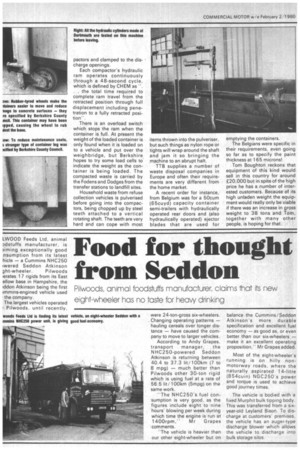Food for thought from Seddon
Page 40

If you've noticed an error in this article please click here to report it so we can fix it.
PlIwoods, animal foodstuffs manufacturer, claims at its new eight-wheeler has no taste for heaw drinking
were 24-ton-gross six-wheelers. Changing operating patterns — hauling cereals over longer distance — have caused the company to move to larger vehicles.
According to Andy Grapes, transport manager, the NHC250-powered Seddon Atkinson is returning between 40.4 to 37,3 lit /100krn (7 to 8 mpg) — much better than Pilwoods other 30-ton rigid which is using fuel at a rate of 56.5 lit/100km (5mpg) on the same work.
'The NHC250's fuel consumption is very good, as the figures include eight to nine hours' blowing per week during which time the engine is run at 1400rpm,– Mr Grapes comments.
"The vehicle is heavier than our other eight-wheeler but on balance the Cummins/Seddon Atkinson's more durable specification and excellent fuel economy — as good as, or even better than our six-wheelers — make it an excellent operating proposition," Mr Grapes added.
Most of the eight-wheeler's running is on hilly nonmotorway roads, where the naturally aspirated 14-litre (854cuin) NGC250's power and torque is used to achieve good journey times.
The vehicle is bodied with a fixed Murphit bulk tipping body. This was transferred from a sixyear-old Leyland Bison_ To discharge at customers' premises, the vehicle has an auger-type discharge blower which allows the vehicle to discharge into bulk storage silos.








































































































































